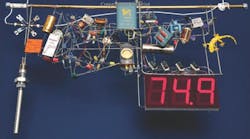How often do you see a coffee-table book for analog engineers? Coffee-table books are grand, lavishly produced extravaganzas, full of fascinating pictures and interesting facts, that sit prominently in your living room and offer new insights every time you open the cover. They’re something that has no equivalent on-line. You wouldn’t want one on your iPad or Kindle. It has to be a real book, a codex, a thing, not a file, something that appeals through its physical presence.
Before he died last summer, Linear Technology’s Jim Williams left us precisely that, Analog Circuit Design, a big book, subtitled: “A tutorial Guide to Applications and Solutions.”
Hardbound, it is an edited compendium of decades of Jim’s appnotes and ideas, 932 pages of the most lucid thinking about analog design, containing decades of insights into what works and what doesn’t. It even includes one of Jim’s original sculptures on the cover. (More on that later.)
It’s ISBN is 978-0-12-385185-7. The book is currently available via Amazon at http://www.amazon.com/Analog-Circuit-Design-Applications-Solutions/dp/0123851858/ref=sr_1_2?s=books&ie=UTF8&qid=1313169774&sr=1-2 or from Elsevier at http://www.elsevierdirect.com/product.jsp?isbn=9780123851857 More info and a video intro from Dobby is at http://www.linear.com/designtools/acd_book.php
As anybody who really cares about analog design, or who had any contact with Jim Williams through the years, might suspect, this is more than a boring roundup of old application notes. Jim was passionately committed to what he did, and he was one of those rare circuits guys know for his lucid prose.
There’s quite a story behind the book. It almost didn’t happen. The guys who got the project out of the stage where you talk about in in the company cafeteria and moving in the direction of becoming a real book were Linear’s CTO Bob Dobkin and John Hamburger, the company’s Marcom Director.
And their first problem was Jim.
Once they all got started with the project, talking to Elsevier and – looking at the sheer mass of material that Jim had developed over the years, deciding what would fit and what wouldn’t – there was a hitch.
Jim came to John and announced he wanted no part of the project. There were too many of “my children” abandoned on the floor, he told John. He was dismayed about what John and Dobby were talking about omitting. “Go ahead with the project, but leave my name off it,” he told John.
